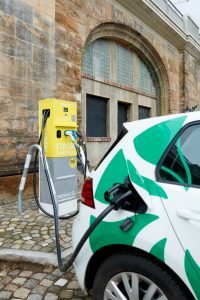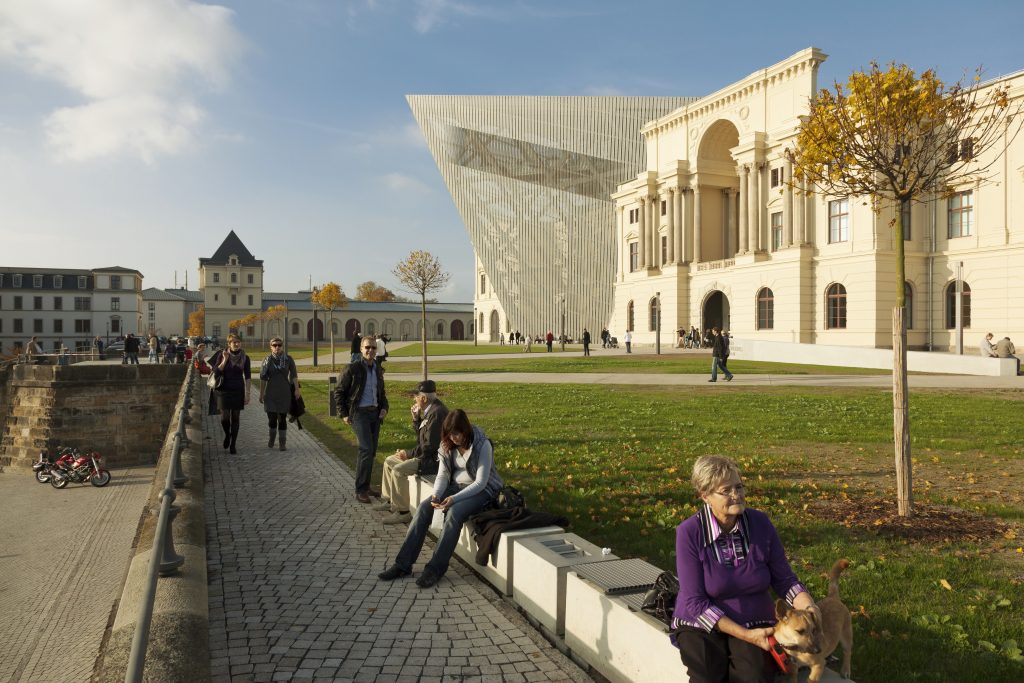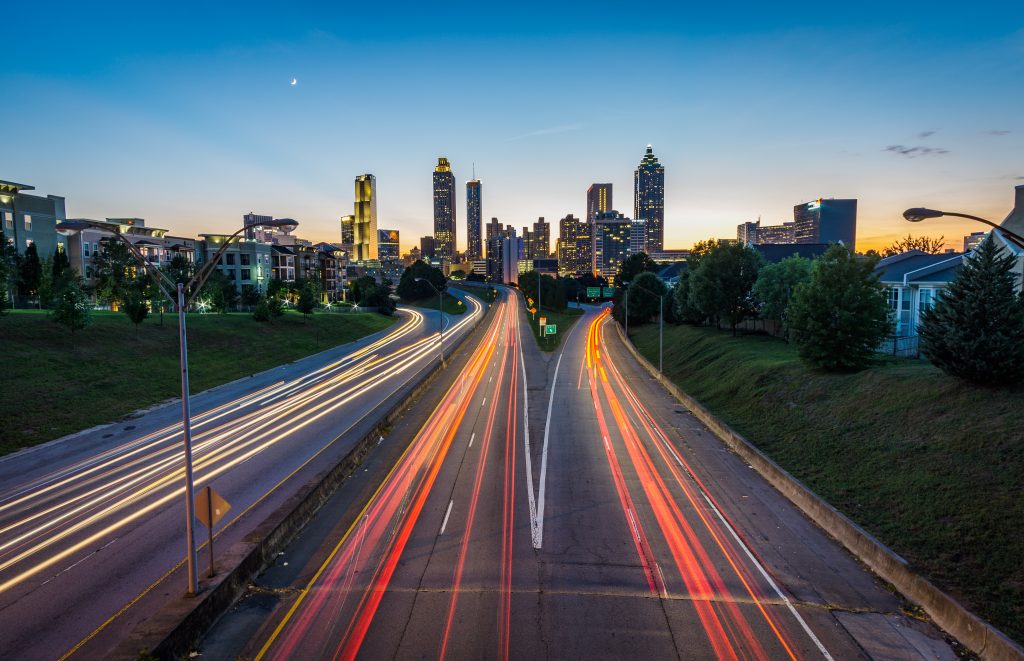Dresden, the state capital of Saxony, Germany wants to set up 76 mobility hubs in the city area. At these stations, users can quickly switch between environmental friendly and city-friendly means of transport such as bicycles, car sharing, electric cars and local public transport. Six of these will be implemented as pilot sites: Pirnaischer Platz, Bahnhof Mitte, Altpieschen, P+R Prohlis, Fetscherplatz and Wasaplatz. Dresdner Verkehrsbetriebe AG (DVB) receives financial support for these pilot sites from the national climate protection initiative. The first mobility hub at Pirnaischer Platz will go into operation on 21 September 2018. Within the framework of the EU Smart City project MAtchUP, the acceptance and reactions of users are collected and evaluated in the first months. In connection with the project, also three mobility hubs will be planned and one implemented in the selected district Johannstadt. These practical experiences flow into the implementation of the other mobility hubs. The “Mobility Points” working group founded by Lord Mayor Dirk Hilbert has presented a technically and technically coordinated basis for a further 24 locations.
In a growing and increasingly dense city, ensuring mobility for all and bringing it into harmony with the quality of life is a challenge for urban development. Dresden is focusing on a comprehensive and sustainable mobility strategy. Intermodal mobility hubs are an important component.
The mobility hubs will be implemented by a network of local partners, consisting of the state capital Dresden, DVB AG and DREWAG – Stadtwerke Dresden GmBH as well as DDV-Medien with sz-bike and the company teilAuto from Halle/Saale as car sharing operators.
“Our goal is to reduce private car engines and vehicle use in order to reduce noise, space requirements and air pollution. But there should be no prohibitions. We want to offer the inhabitants of Dresden comfortable and fast mobility for their work and leisure activities. With smart and urban-friendly offers we will promote environmentally friendly mobility”, Transport Mayor Raoul Schmidt-Lamontain outlines the strategy. “Public transports as well as bicycle and foot traffic are space-saving, low-emission and health-promoting. Electric mobility is to be promoted. The ‘sharing instead of owning’ approach is also important, as it means fewer vehicles are required and high-quality, urban space can be recovered,” Schmidt-Lamontain continues. Andreas Hemmersbach, Member of the Board of Managing Directors of DVB, adds: “We want to integrate car sharing and bicycle rental even better with public transport and thus expand our range of services. We want our customers to experience new mobility options without this affecting the ticket price.”
Planning Background
The City Council decided to establish a network of mobility hubs with the Sustainable Urban Mobility Plan 2025plus in November 2014 and the implementation began in early 2015. First, the city administration created the conceptual basis with an operator concept and a local cooperation structure. Locations were examined. Following political discussion and a decision by the City Council in March 2017, the legal basis was established by adjusting the public service contract for DVB AG and the special use charter. Mobility stations for linking public transport with other traffic carriers such as bicycle rental systems, car sharing and electromobility, including the associated installations, (charging) infrastructures, information and advertising facilities are thus special uses free of charge. The road authority has already ordered free parking for Pirnaischer Platz during the loading process. The Electric Mobility Act allows free parking during the charging process. However, this must be verified separately for each location and ordered under traffic law. The new parking and garage regulations also include incentives to create car sharing parking spaces. From June 2017 to September 2017, the campaign “Multimobil. For you. For Dresden” was conducted, with which the citizens of Dresden learned a lot about intermodal mobility. Information on the mobility hubs can be found on the Dresden website.
Strategy
In contrast to some other German cities, in Dresden, a city-wide uniform system is to be developed under the auspices of local actors. The services bundled in it will offer a high level of service quality and be durable. Services should be reliable in the long term, because otherwise the strategic goal of less private car use cannot be achieved. From a technical point of view, high flexibility is necessary because the development of the charging infrastructure and digital services is very dynamic. The Dresden Mobility Hubs will therefore not receive any fixed IT installations, monitors or the like. The charging infrastructure will also be separately operable in order to react to technical developments and to be able to exchange or add individual components.
Charging Infrastructure

MAtchUP and its partners
The MAtchUP project secured the financing of the implementation of new electromobility solutions, including the expansion of an innovative charging infrastructure, multimodality strategies and improved logistic solutions. This project revolves around creating smarter, clean cities capable of handling the challenges of climate change. Followers are expected to benefit from the Lighthouse Cities’ knowledge, and use this accordingly for their own transformation processes. The aim is to bring cities, industry and citizens together to implement solutions and business models which generate measurable success in areas such as energy and resource efficiency and new markets.
The Urban Planning Office, Division for Mobility Development of the Saxon state capital Dresden develops strategies for mobility development in Dresden. It thus sets goals and constructs and monitors measures for a sustainable and effective transport system. It established the strategic foundation for the mobility hubs. In MAtchUP the Division for Mobility Development takes the role of a leader of mobility issues of the Municipality.
The Economic Development Office of the Saxon state capital Dresden coordinates the work in MAtchUP in Dresden. It brings together partners from business, research and administration. “Think global – act local” – according to this motto, the Office for Economic Development is working specifically on maintaining and expanding the growth conditions for an internationally competitive and sustainable development of economy, education and research in Dresden. It supports local companies and start-ups on a wide range of issues, assists investors and coordinates the development towards a smart city.
Dresdener Verkehrsbetriebe AG (DVB) operates the public transport of Dresden with a dense network of tram and bus lines, ferry connections mountain railways. On weekdays, about half a million passengers use the transport services of the DVB. Therefor the company contributes to relieving the strain on the roads, protecting the environment and preserving Dresden as a city worth living in. The customers of DVB appreciate short cycle times, low-floor vehicles, barrier-free stops and comprehensive information. The DVB is also an attractive employer and training company for the city and the region.
DREWAG – Stadtwerke Dresden GmbH supplies some 300,000 customers with electricity, gas, district heating and drinking water. With its roots in Dresden, its staff works to ensure a reliable, sustainable energy supply for the state capital, while the source of added value stays within the region. Most of the electricity, district heating and drinking water are self-produced. The staff is based locally in Dresden – making customer proximity and customised energy services additional strengths along with environmentally friendly energy production. As an employer and trainer, DREWAG is also an important job driver for Dresden and the surrounding region.


